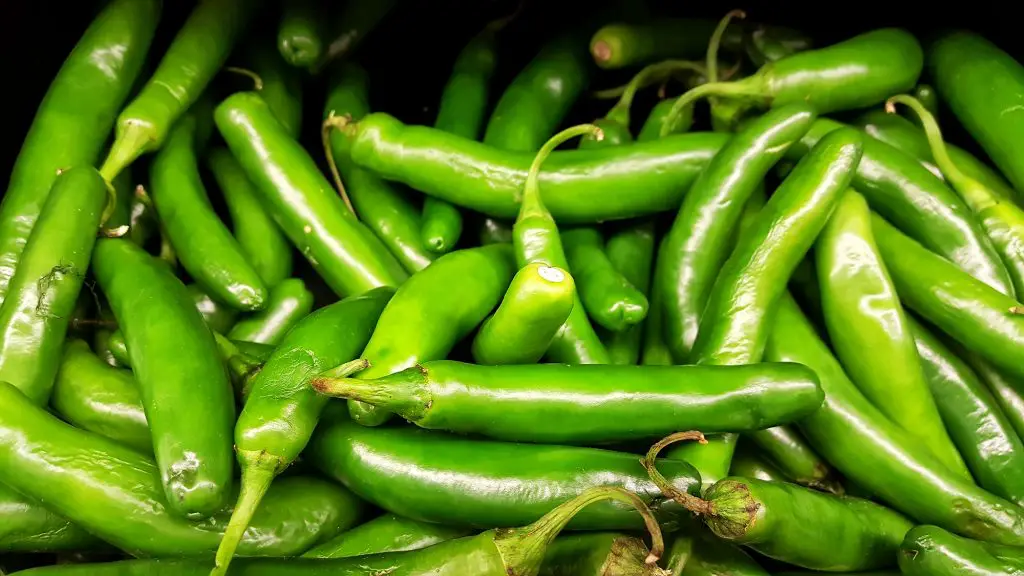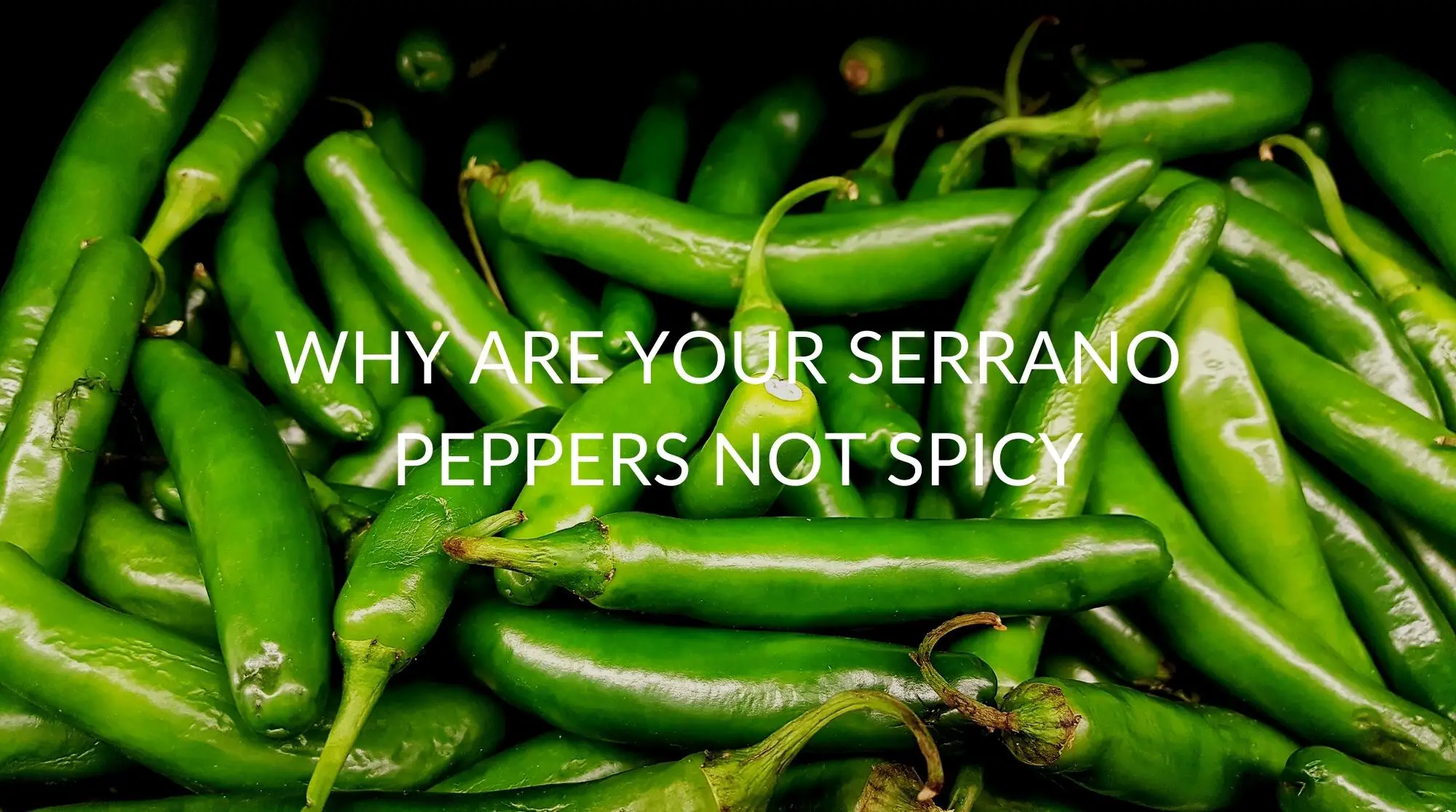Are you growing serrano chiles at home? Are they not as spicy as you expected?
There are a number of factors that contribute to how spicy your peppers will be when grown at home. If your peppers are not as spicy as you expected here are a few things to consider.
If your chile plant is getting too much water or too much fertilizer it can make the serrano chiles milder. If your chile plant is not getting enough sunlight or if the temperature is not warm enough, your serranos will be milder.
If the soil doesn’t have the right pH balance or nutrients, your serranos may be milder. Lastly, if your serranos are planted near milder chiles they may cross-pollinate and the serranos will be milder.
Why Are Your Serrano Peppers Not Spicy?
Serrano chiles are typically 10,000 to 23,000 S.H.U. on the Scoville Scale. This number varies depending on who you talk to or where you get your information. Some say that serranos can be as mild as 5,000 s.h.u.
The factors below can all contribute to the spiciness or lack thereof in your serranos. When trying to determine which one or ones might be the problem test them one by one.
Too Much Fertilizer
This may come as a surprise but when it comes to chiles too much fertilizer can cause mild flavor. Fertilizer helps plants grow bigger. When it comes to chile peppers, the bigger they grow the milder their flavor can become.
Too Much Water
This is another one that might surprise you. Unfortunately, it is easy to overwater your chile pepper plant. If you overwater you serranos. Similar to fertilizer, too much water will dilute the spiciness of your chiles.
Cross Pollinated with Milder Pepper
Your serranos might be milder in spice if they have cross-pollinated with milder chile pepper. If you are growing many different kinds of chiles in the same area, you will likely end up with cross-pollinated chiles.
Wondering why your Serrano Peppers are turning red? Click here!
Not Warm Enough
The temperature of the area where your chiles are growing can also affect how spicy they are. Typically, warmer temperatures create spicier chile peppers. Chiles that do not get enough heat will not grow as well. Temperature affects the nutrition information and that includes the capsaicin that makes chiles spicy.
Not Sunny Enough
Similar to heat, the sun affects how spicy your chile peppers are. Serranos that do not get enough sunlight will be milder than those that get enough or more than enough sunlight.
Soil Lacking Nutrients
Most plants prefer certain nutrients in the soil. This differs from plant to plant. If the soil your serranos are growing in does not have the proper nutrients, then you may end up with milder peppers.
Factors for Serrano Peppers Not Getting Hot
The following factors can help or hinder your serrano plant’s ability to grow spicy peppers. The good news is that you can control most of these factors in one way or another. If you are growing your chile peppers outside you have less control than if you are growing them inside.
Temperature and Climate
Serrano chile plants prefer temperatures of 70-90 degrees Fahrenheit. The ideal temperature to get spicy peppers is around 80 degrees Fahrenheit.
If your peppers are growing outside you have no control over how hot or cold it is. If your peppers are being grown inside, try to keep the temperature consistent and at 80 degrees Fahrenheit.
Serrano peppers also need a lot of sunlight. More sunlight is best for spicy peppers. They prefer to have sunlight for at least twelve hours a day.
Soil ; Fertilizer
Serrano chile plants like soil with a pH of 7.0 to 8.5. Use a small amount of fertilizer or make sure your soil also has calcium, phosphorous, and potassium. Some nitrogen is okay, but too much nitrogen can cause your serranos to grow milder instead of spicier.
Water
Serrano peppers are native to certain regions of Mexico. They prefer water every four to five days. You want to make sure they have a pot that drains well if you are growing them in a pot. If they are growing outside, you can water them a little more often if the soil is dry.
Cross Pollinating
Serrano peppers that have cross-pollinated with a milder chile such as a Jalapeno, Poblano, or Anaheim will be less spicy. Cross-pollinating is fairly common amongst chile pepper plants.

How To Make Your Serrano Peppers Hotter
If you want to make your serrano peppers hotter, then you need to have as much control over their environment as you can. The best way to do this is to grow them inside. The following factors affect the spiciness of your chiles, so it is important to find the right amount of each for your serranos.
Temperature
It is easy enough to determine if the temperature might be affecting your serrano chiles. If your chiles are growing outside check the hourly temperature readings. If they ever drop below 70 degrees Fahrenheit it is a good bet that the temperature is affecting your serranos.
Taking your chilies inside or growing them inside will allow you to control the temperature. Serranos’ ideal temperature is 80 degrees Fahrenheit. If this is too hot for you to live comfortably in your house, consider building a greenhouse or installing a heater specifically for the room where your chiles are being kept.
Water
To determine if you are overwatering, check the soil dampness of your plant. If your soil is consistently damp, you are overwatering. Another way to check is to water less and see if it makes a difference in your next round of peppers.
If you determine that water is the cause of your mild serranos, decrease how much and how often you are watering.
Light
To determine how much light your chiles are getting there are a few things you can do. First, check the times of sunrise and sunset. If they are less than twelve hours apart your serranos are not getting enough sunlight.
There is an easy fix for this problem. You can purchase a grow light and run it for a couple of extra hours each day so that your serranos are getting a minimum of twelve hours of sunlight. They enjoy getting up to sixteen hours of sunlight.
Soil
The best case is to use only a little bit of fertilizer. To determine if you are using too much fertilizer, look at the size of your serranos. Serranos are typically one to four inches long. If yours are bigger than that, fertilizer might be the problem.
If you determine that your chiles are growing too big and therefore distributing the heat and causing an overall mild flavor, then stop using fertilizer completely.
There are tests you can run to check the nutrients in the soil. If you find that your soil is missing any of the necessary nutrients, look for additives that you can add to water that have those nutrients. Be sure to follow the directions on the container.
Maturation
Mature peppers are spicier than unripe peppers. However, if you let the chiles stay on the plant too long the ripe peppers signal the plant that it is time to stop producing peppers. Picking your serranos as soon as they start to show signs of maturation is best.
Purity
If your serranos have been cross-pollinating with other milder chile peppers, there is really only one solution. You have to control the pollination. This is usually achieved by growing the peppers indoors away from pollinating insects. You then need to pollinate the plant yourself.
FAQ
Does Hot Weather Make Peppers Hotter?
Hot weather does affect how hot your peppers are. A temperature of 80 to 90 degrees Fahrenheit will cause your peppers to be spicier so long as other conditions are met such as adequate water and good soil.
Hot weather also means more sunlight. Plenty of good sunlight will also improve the spiciness of peppers.
Recap
There are many factors that contribute to the level of heat your serrano peppers may have. If even one of those factors is off, it can affect the whole plant. Luckily, it is easy to solve most of these problems and grow nice and spicy serrano peppers.


Interesting. I accidentally purchased Serranos thinking the were the mild Italian pickled peppers. I can use this information to reduce how hot they are.